
- Index
- Certification
- Anacs (13)
- Bullion (2)
- Certified By Mint (4)
- Coa (26)
- Gsc (8)
- Iccs (4)
- Mint Certification (3)
- Mint Certified (3)
- Ngc (263)
- Nzmint (2)
- Pcgs (99)
- Pls See Photos (3)
- Rcm (56)
- Rcm Coa (149)
- Royal Canadian Mimt (2)
- Royal Canadian Mint (262)
- Serialized (4)
- U.s. Mint (2)
- Uncertified (1402)
- Yes (8)
- Other (425)
- Composition
- Denomination
- Fineness
- Grade
- Km Number
2023 Pingualuit Crater Crystal Eye of Nunavik Silver Coin Royal Canadian Mint

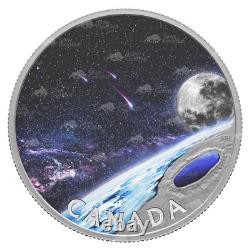
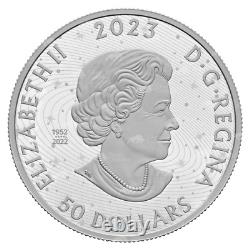
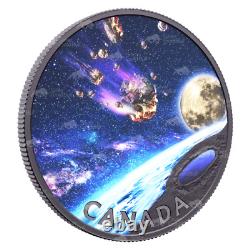

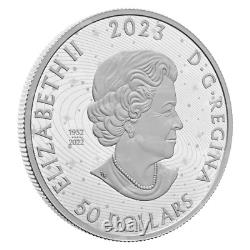
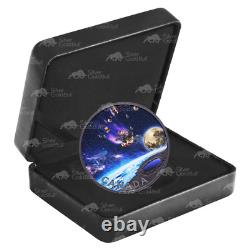


Discovery the beauty of Pingualuit Crater Lake. Then activate the black light paint technology to see how it came to be! In the heart of the lunar-esque landscape of the Ungava Peninsula, in Nunavik, Quebec, lies a breathtaking lake with pure blue waters that stand out in any aerial view. A geological marvel, Pingualuit Crater Lake was created when a meteorite struck the Earth approximately 1.4 million years ago.
This colourful 99.99% pure silver coin offers you an awe-inspiring view of the natural wonder: under normal light, you see the Crystal Eye of Nunavik peering out into space; under a black light, the reverse design whisks you back in time for a view of the landscape-altering meteorite, mere moments before it slammed into prehistoric Canada and left an almost perfectly circular impact scar. Enjoy a space view of the Crystal Eye-and the prehistoric meteorite that created it!
SPECIAL FEATURES Brace for impact! Discover a marvel of nature, one uniquely shaped by a meteorite that collided with Earth 1.4 million years ago.Journey through space and time. This gives you a front-row seat to an impact event that occurred 1.4 million years ago-an event that produced one of Canada's most amazing natural physical features, and one of the most impressive meteorite craters on Earth. For the love of science and art. It's the perfect collectible or gift for astronomers, sky gazers, geologists and explorers. Only 2,500 coins are available to collectors worldwide.
Don't miss out-order yours today! The Royal Canadian Mint certifies all of its collector coins. Meteorites often strike at an angle, but the one that created Pingualuit Crater Lake came down almost vertically, resulting in the near-perfect circle imprinted on the earth's surface. The impact created a ring that measures 3.4 kilometres in diameter, and when the ice sheet receded during the last ice age, water filled the crater to form a lake that is 267 metres deep.
Because there are no inflows or outlets, the lake holds some of the clearest freshwater on Earth. It's also home to a single species of fish, the Arctic char. Though no one knows how the fish got there.
Formerly known as Chubb Crater and New Quebec Crater, Pingualuit Crater Lake was the first meteorite crater to be recognized in Canada (others have since been identified). Local Nunavimmiut have long known about its existence, and it is regarded as a sacred site of healing. Outside of the Pingualuit region, the crater lake was a well-kept secret until 1943, when an American aircrew spotted it. Its unusual shape and vivid colour made it a useful navigational aid for pilots, and because of its remote location, geological expeditions to the crater didn't begin until the 1950s.
Thanks to the crater's deep (400 metres) shape, sediment deposits at the bottom of Pingualuit Crater Lake escaped glacial erosion and are remarkably well preserved. These sediments have yielded information about climate change, and they provide a long-term record of environmental history dating back to (at least) the last two glacial periods. DESIGN & ARTIST Designed by Canadian artist Neil Hamelin, the coin's reverse features a colourful space view of Pingualuit Crater Lake on the Ungava Peninsula, in Nunavik, Quebec. Above the blue circular lake and its (engraved) surroundings, the detailed depiction of the Moon, the shooting stars and the Milky Way inspire awe for the wonders of the cosmos, and a deeper understanding of both the splendour and vulnerability of Earth. These elements glow when viewed under black light, which reveals a second image: a view of the meteorite on its collision course with Earth and directly above its eventual impact site. The obverse features the effigy of Queen Elizabeth II by Susanna Blunt.The obverse also bears a special marking that includes four pearls symbolizing the four effigies that have graced Canadian coins and the double date of her reign. It was an incredible amount of fun designing this coin and telling the story of pre and post impact of the Pingauluit Crater. I hope this coin will have a similar impact! " NEIL HAMELIN, ARTIST "One of the world's deepest crater lakes, Pingualuit Crater Lake is stunning and truly unique because of its perfect circular shape, its deep blue colour, and its steep crater rim that stands out significantly over the flat tundra landscape. This site has caught the attention and imagination of scientists because the lake's origins are extraterrestrial, and because its waters are among the purest in the world; fed only by rain, the lake basically emulates a huge rainwater collector in the middle of the barren tundra!
But the real treasure is the wealth of stories its deep waters and sediments can tell. Deciphering the 1.4-million-year history of natural climate variability from the Pingualuit Crater Lake sediment archives will reveal important clues about climate change and how ecosystems adapted over many glacial-interglacial age cycles-in essence, Pingualuit Crater Lake is a precious scientific time capsule.
REINHARD PIENITZ, PROFESSOR, DEPARTMENT OF GEOGRAPHY AT UNIVERSITÉ LAVAL The weather was perfect, enough wind to keep the mosquitoes away when I first saw the crater and marvelled at the beauty of its deep blue colours. I put my feet in to really feel it's beauty MARY A.
DIRECTOR PACKAGING Each coin is encapsulated and presented in a Royal Canadian Mint-branded clamshell with a black beauty box. ABOUT THE ROYAL CANADIAN MINT The Royal Canadian Mint is known as one of the most reputable mints in the world. The Ottawa Branch of the Royal Mint opened in 1908 and was renamed The Royal Canadian Mint in 1931 when control was transferred to the Canadian government. The Royal Canadian Mint is renowned for producing some of the highest quality and purity of gold and silver bullion coins and bars in the world. Their high standards for excellence and quality allowed them to be the first refinery to manufacture 9999 fine gold bullion coins in 1982, as well as the first to reach 99999 fine gold purity in 1999.
